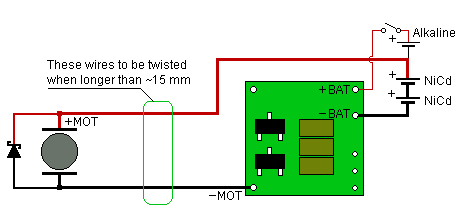
mm-2cel.htm; updated: 23 October 2002

MicroMag Application: Two NiCd or NiMH Cells
The new Lithium cells makes the use of 2 NiCd cells redundant in most cases. Sometimes however there still can be a wish to use 2 NiCd or NiMH cells. The KP-00 motor e.g. runs very happy on 2 cells. NiCd's and NiMH are also cheaper.
Two cell operation
of the standard MicroMag is OK with CO2 or gliders.
At low current the end-voltage is 2.2 volts, which is just high
enough for the MicroMag.
With electric power the situation is different. At load the cell voltage will be 1.1 volt to start with, and we easily drain the cell down to 0.8 volts. This is too low to drive the receiver.
When two 50 mAh
Sanyo cells are used to power the motor and a small alkaline cell
is added to increase the voltage to the receiver the system will
work fine. The solution is simple, just reroute some wires will
do. To make it simple and avoid any change to the ESC the
addition of a small 0.5 to 1 Amp lowvoltage schottky diode over
the motor is used.
Proven schottky's are the original Zetex SZ1000 is fine but not
easy to get or to solder, the IRF10BQ015 which is SMD as well but
easier to use.
Probably perfect is the 1N5817 which is leaded, small, low
voltage, 1 Amp, cheap and available. Note that the band on the
diode goes to the plus terminal of the motor.
Note that a small switch might be added to power the system on-off. The 2 NiCd's can be hard wired when you like. With the alkaline battery switched off, there is no significant current drain. Alternatively the alkaline cell can be placed in a small balsa box with copper foil contacts. Inserting the cell will power the system on.

The best (and in this case the cheapest) way to get the right type of alkaline cells is to buy a 12 volt photo battery, the one of about 10 mm (3/8") diameter and 26 mm (1") long. Strip the steel case and one 12 volt pack will provide you with 8 cells usually marked with LR932 or L932. These cells will give you 30 to 60 minutes flying time each. Not too bad at 0.7 grams per cell.
Copyright © 1999
Ruijsink Dynamic Engineering. All trademarks shown are trademarks
of their respective owners. All rights reserved.
http://www.ruijsink.nl, designed by Rick Ruijsink